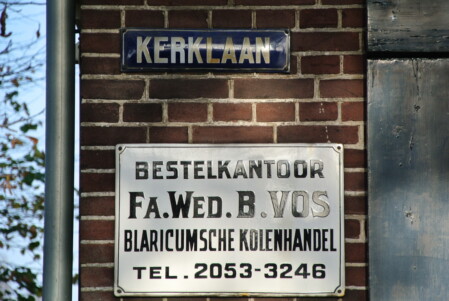.
The Coal and Fuel Business of the Vos Family
The Vos family's coal business has been a household name in Blaricum for over a century.
Below is a summary of the history of this family business.
The company was founded in 1887 by Bartus Vos. He married Aaltje Raven on April 17, 1894.
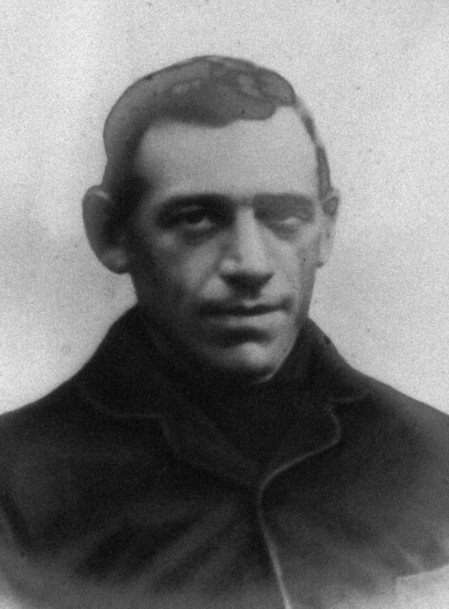
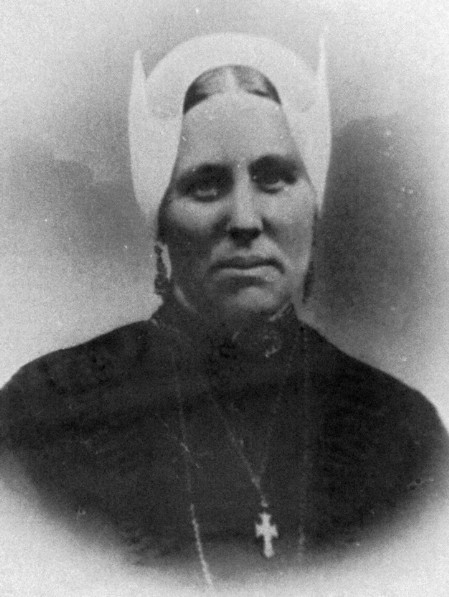
They had nine children:
Geertruida Vos 1895-1980
Hendrica Vos 1898-1989
Jacobus Vos 1900-1985
Hendrika Vos 1902-1902
Hendrik Vos 1903-1977
Lambertus Vos 1905-1917
Alida Vos 1908-1908
Geurt Vos 1909-2004
Willem Vos 1913-2003
He was an erfgooier and farmer. They lived in the old farmhouse on the property next to the garage, which later became the garage.
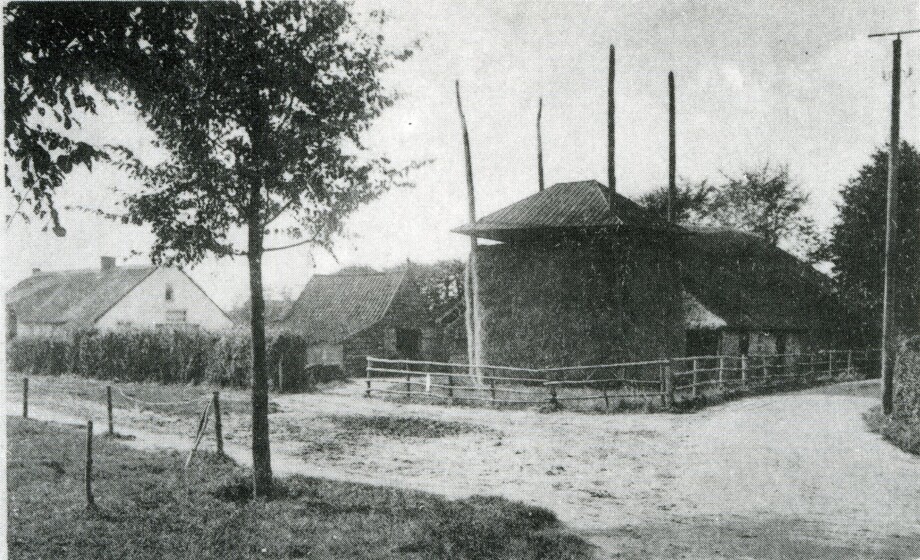
Above, the farm and haystack; the photo is from before 1918. The roads were still unpaved. The small building to the left of the haystack is the peat barn.
Bart started selling milk, clay, wood, and peat 130 years ago.
Bart Vos himself was a farmer with his father but had to earn extra money because, as he was only allowed to graze seven cows and one horse on the common grounds. Hence he started a kind of buttermilk district in Hilversum.
He left in the morning with his barrels of buttermilk for Hilversum, where he sold the dairy product, which he obtained from the farmers of Blaricum.
Bart Vos's family had to survive on almost nothing, as earnings were very low. To live a little less impoverished, Bart started selling fuel on a very small scale. In the beginning, this business was practically nothing. When the buttermilk was sold in Hilversum, Bart, before returning to Blaricum, would go to Kuilenburg, who was a greengrocer and was also trading coal in the Veerstraat, to pick up a half or a quarter bushel of fattening coal or hard coal. Upon returning home, one of the two daughters—the boys were all still very young—would take the coal to the customer who had ordered it. Thus, the Blaricum coal shop B. Vos en Zonen was born.
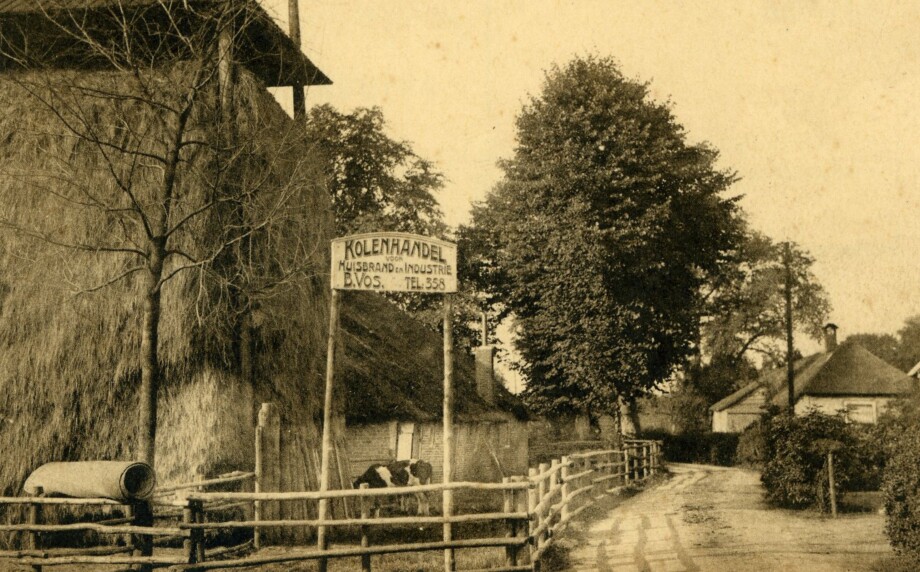
Above is a photo of the farm with a sign for the coal trade.
The four sons, Jaap, Willem, Henk, and Geurt, expanded the business to include the sale of wood, peat, and especially coal, but in between they also milked cows, fed the pigs, and tended the vegetable garden. The cellar was filled with jars of pickled beans and other items. They were all always working, and meals were eaten in the barn. Seven days a week, from 5:30 in the morning onward, because the milk cans had to be at the factory by 7:30.
During the 1914-1918 war, the coal, which was rationed at the time, was transported by rail to Blaricum by lorry. Later (around 1925), the coal had to be collected from the small station in Laren again. By then, a Model T Ford had been purchased.
The national highway was constructed in the 1920s and 1930s. Lorry-drawn trucks, pulled by locomotives, were used to transport the necessary sand. B. Vos was able to deliver 146 wagons of briquettes for these tractors in about nine months. A considerable undertaking, but a rewarding order. Things kept improving. A second lorry was purchased, this time a refurbished "T" Ford with spoked wheels (see the photo below).
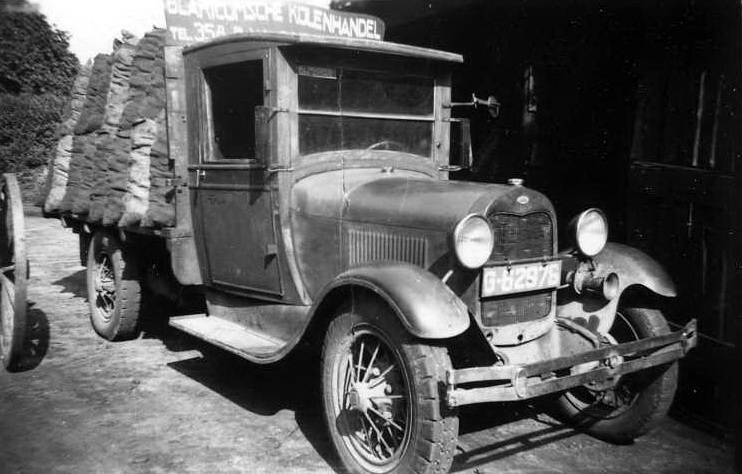
Below is an advertisement from the Gooi en Eemlander newspaper of January 2, 1932


Bart died that year on February 29, 1932, and the name of the coal trading company was changed to Blaricumsche Brandstoffenhandel Fa. Wed. B. Vos en Zonen.
The advertisement from the Gooi en Eemlander newspaper dated December 31, 1934, with the new name is shown next to it.
Below is a photo of three brothers at the coal shop. From left to right, we see Geurt, Henk, and Jaap.
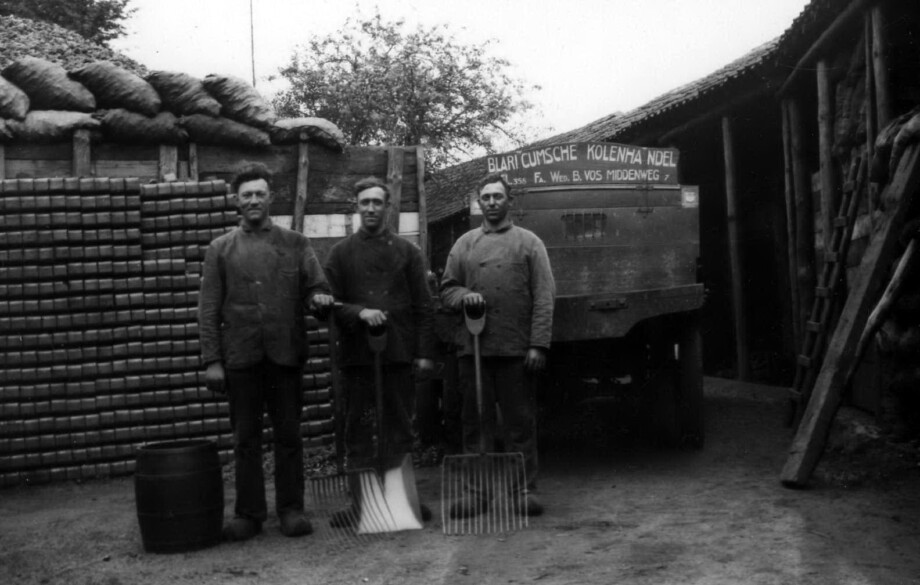
Behind them, we see the briquettes stacked. The barrel next to Geurt was filled with approximately 50 litre of coal.
Bep Vos, Jaap's son, still remembers the coal trade well. "My father and Uncle Henk delivered the coal to Blaricum, Laren, and Eemnes by horse and cart. Uncle Geurt served Huizen and had his own truck for that purpose, a Ford. In those pre-war days, this was, of course, quite unusual," he recalls.
"The coal arrived in Huizen by steam tram, the Gooische Moordenaar, where my father and uncles would empty the wagons by hand and transport them in sacks. I always loved going along. When we returned to Blaricum with a full load, I helped push the wagon up the Huizerhoogt because otherwise it would have been too heavy for the horse."
Besides the Vos brothers, others were also employed in the coal trade; see the photo below.
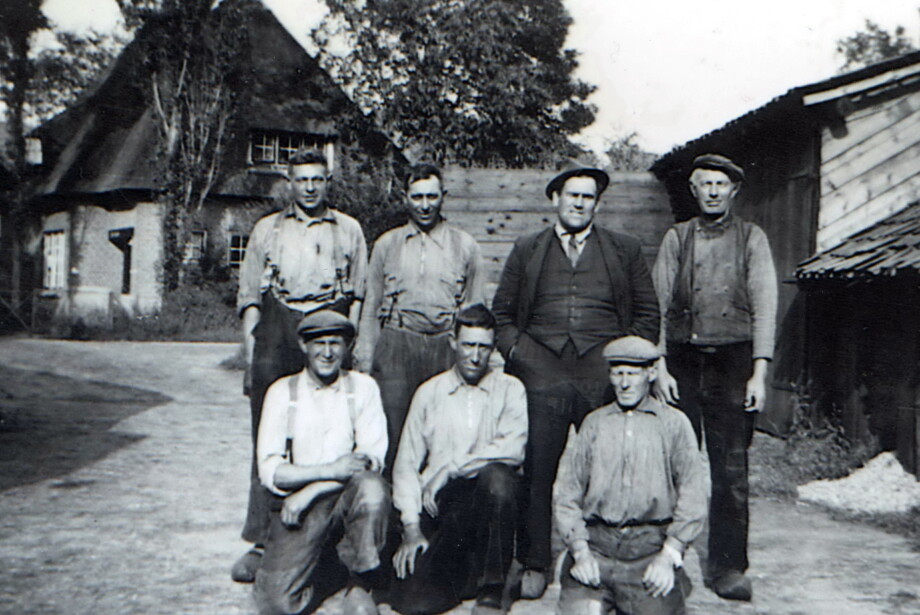
Rear, from left to right: Bep Majoor, Jaap Vos, Willem Vos, and Jaap Raven (Brouwer).
Front, from left to right: Lammert Majoor, Henk Vos, and Meep Raven (Lossie).
During World War II, the brothers' business continued as best it could, without being particularly helpful to the occupying forces. It was no coincidence, for example, that the engine from Geurt's Ford disappeared for unexplained repair purposes. "The German army was therefore never able to confiscate the car," says Bep Vos with a smile.
Bep Vos vividly remembers the liberation in May 1945 and how the people of Blaricum celebrated for days. The company of Wed. B. Vos was also represented in the parade with a large float, painted red, white, and blue.
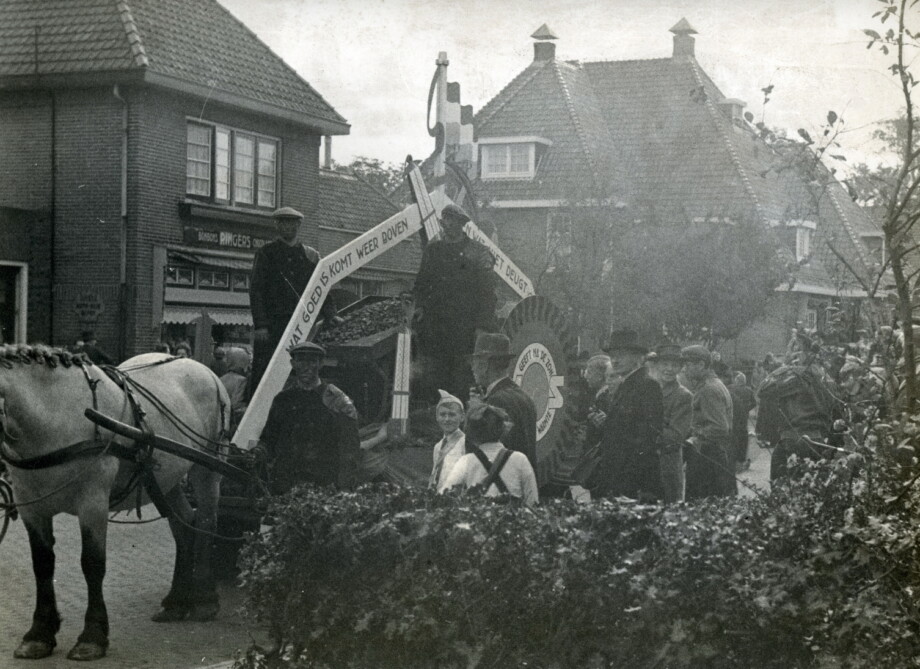
On the float we see Jaap and Geurt, and in front of them Henk.
"After the war, many new neighborhoods were built, especially in Laren and Huizen. All those houses had a coal stove. A golden age dawned for my father and his brothers," he continues. "Instead of horse and cart, the Vos brothers started driving converted army vehicles. A Commer for uncle Henk, a Dodge for uncle Geurt, and a front-steering vehicle for my father, Jaap."
Below, the Commer and Dodge are shown on the left and right, respectively.
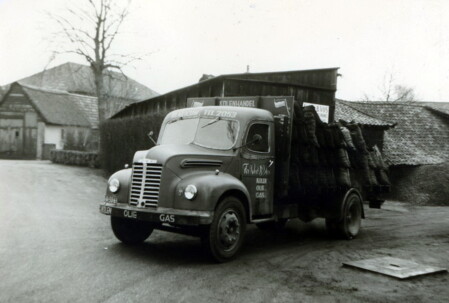
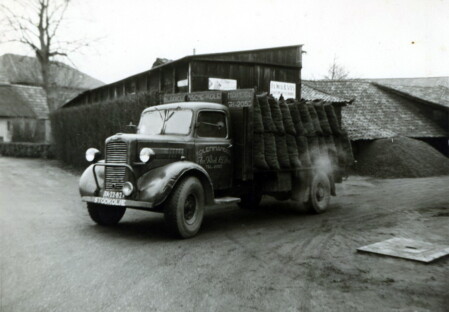
Below, Jaap Vos is haying in the fields with the Ford truck. The second photo shows the same truck, which was also used for transporting coal and briquettes.
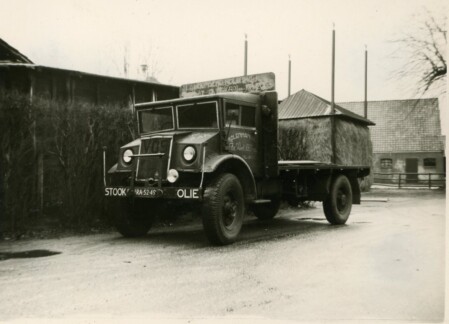
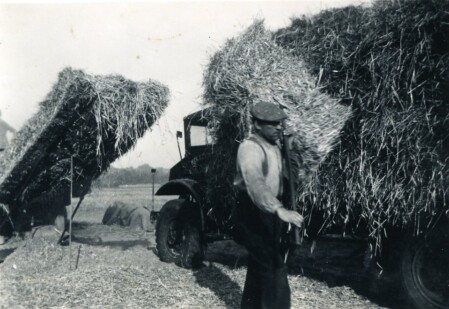
Below is another truck, the Fargo. The left photo shows it loaded with bags of coal. The right photo features bulkheads so loose cargo could also be transported.
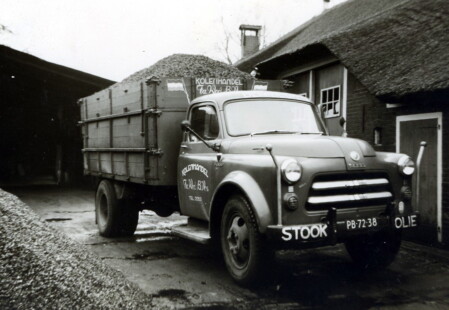
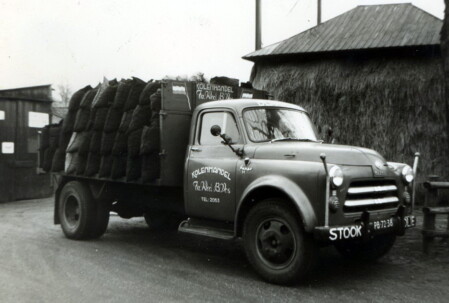
Below is a group photo of all the employees, 11 in total. Geertje (sister of the Vos brothers) is also included.
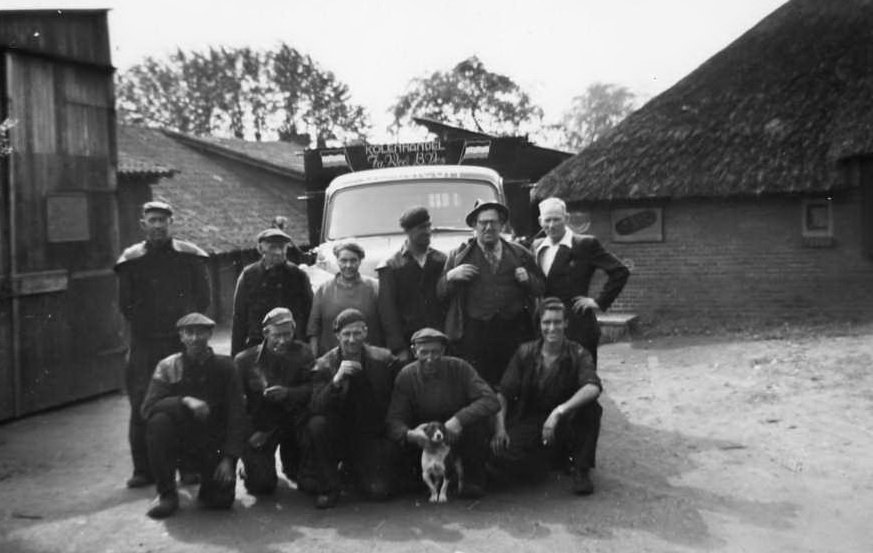
From left to right: Geurt, Meep Raven, Geertje, Gijs de Graaf, Willem, Toon Wilgenborg
From left to right: Jaap, Theo de Leeuw, Jan van den Akker, Henk, Bep Vos
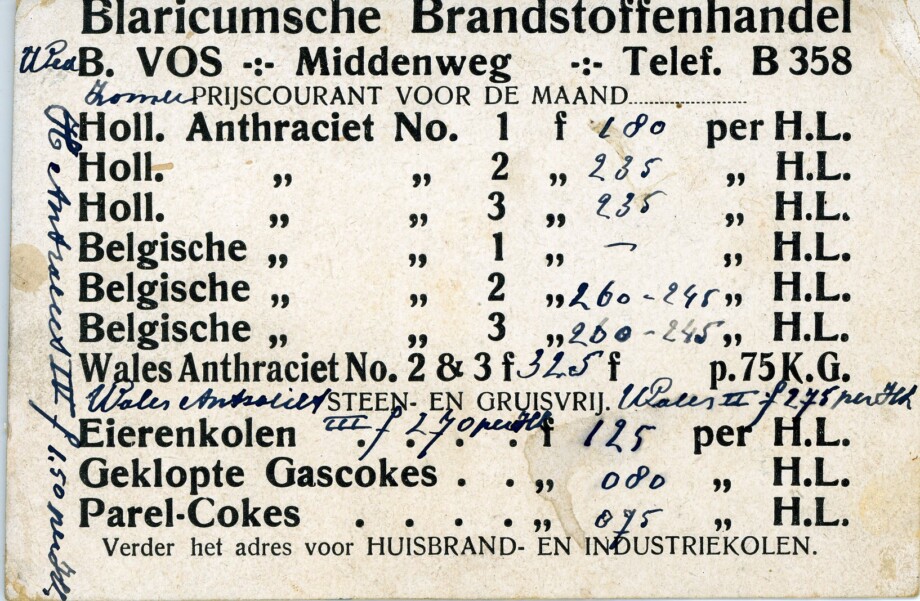
On both price cards we see a large number of types of coal and coke and their prices.
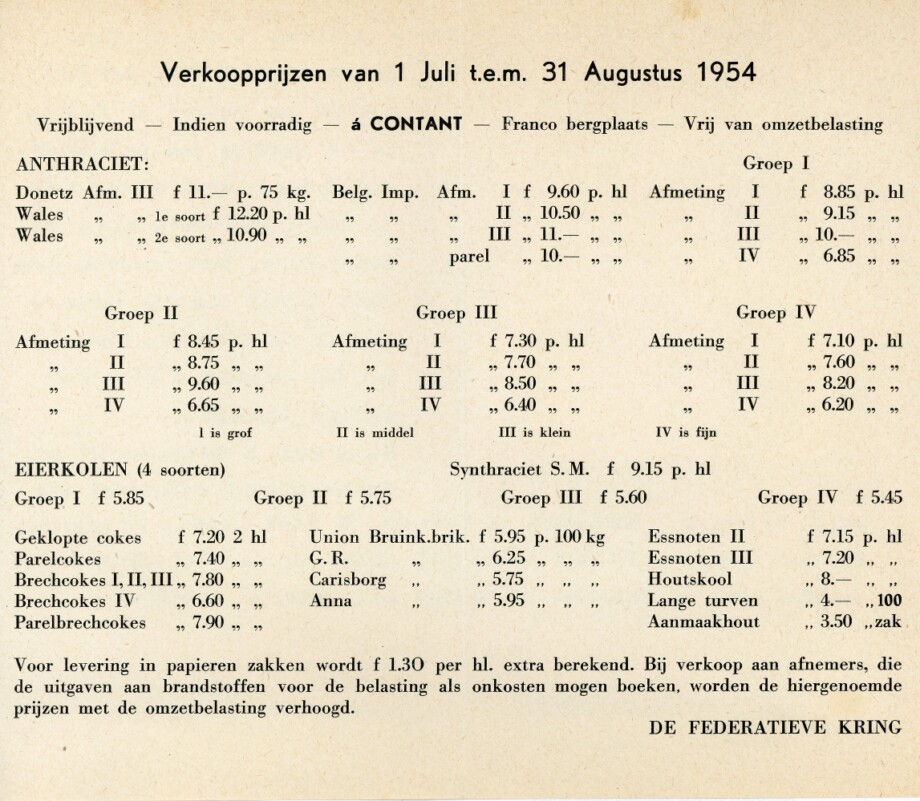
Gerard, Jaap's son, also took over his father's coal business. He vividly remembers this happening on his aunt Geertje's birthday on October 3, 1960. He started by delivering the coal in a wheelbarrow.
Willem was more or less the company's representative. Because Willem, Geurt, Henk, and Jaap were often away from home, Geertje became more or less the manager. She answered the phone calls, did the bookkeeping, and organized the trucks.
Later, Gerard delivered the orders on a bicycle with a two-wheeled cart behind it. And later, he and his father Jaap and the driver Gijs de Graaf toured the village by truck. Once he got his driver's license, he drove himself to the station in Bussum to unload the coal trucks and transport the coal to Blaricum, and he also delivered oil to customers in a tanker truck.
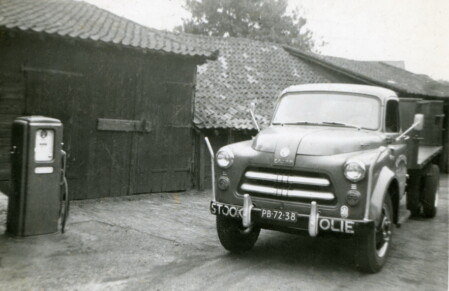
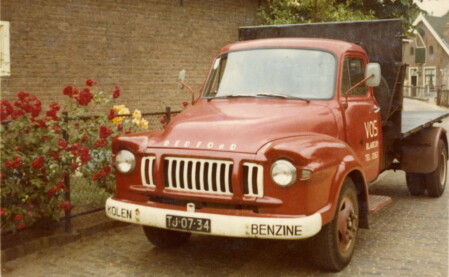
The Fargo truck at the gas station
The Bedford, often used by Gerard
Coal was transported not only by truck, but sometimes also in small quantities.
Paper bags were used for this. Two examples are shown here.
The right bag reads "Only coal provides living heat."
The left bag reads "Anthracite and sunshine."
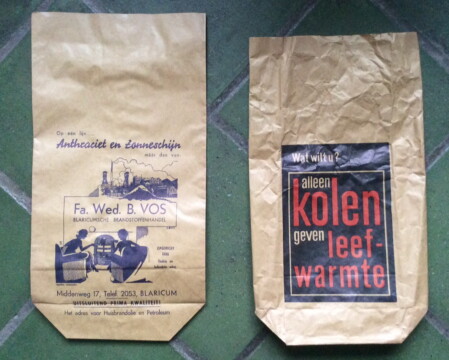
In the 1960s, the coal trade came to an abrupt end when a gas field was discovered in the province of Groningen. The Vos brothers' coal business also suffered, and they decided to focus on selling fuel oil and kerosene.
In 1960, underground tanks were installed for heating oil and kerosene.
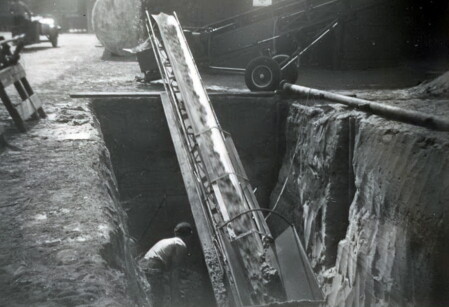
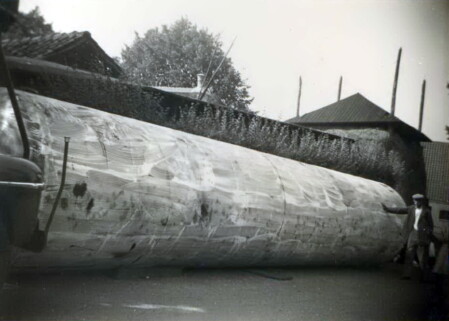
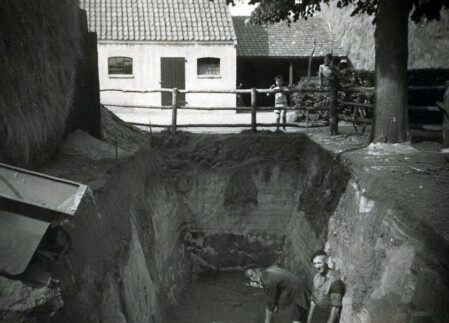
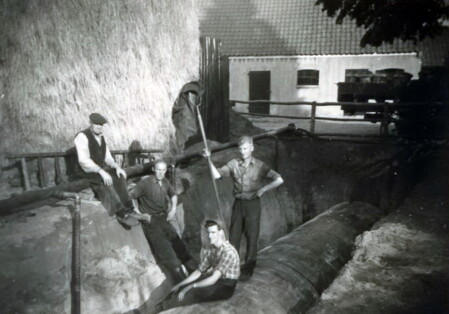
Two tankers were purchased. Bep, Henk's son, had the cab painted red and the body white and blue. These were the colors the company would retain for a long time.
Below are two photos of the Austin: on the left, still under construction, and on the right, as a tanker.
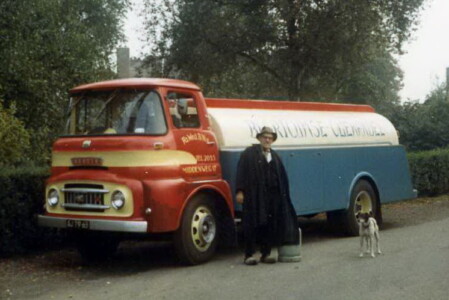
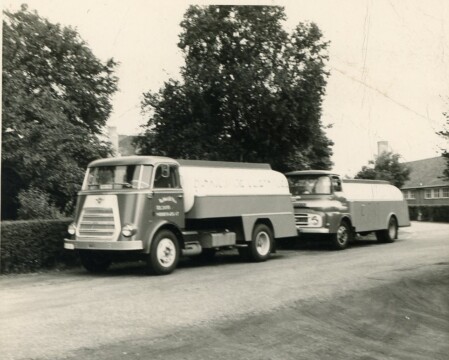
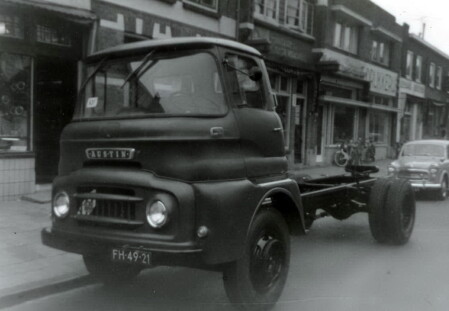
In Soest, it was fitted with a body by the Dijssel company and given the red, white, and blue livery.
In the photo on the right, Willem Vos is standing next to the new tanker.
The photo above shows a DAF petroleum tanker and the Austin tanker, both in the same livery.
The arrival of natural gas led to the company expanding with a gasoline pump in 1967.
This required the installation of additional underground tanks.
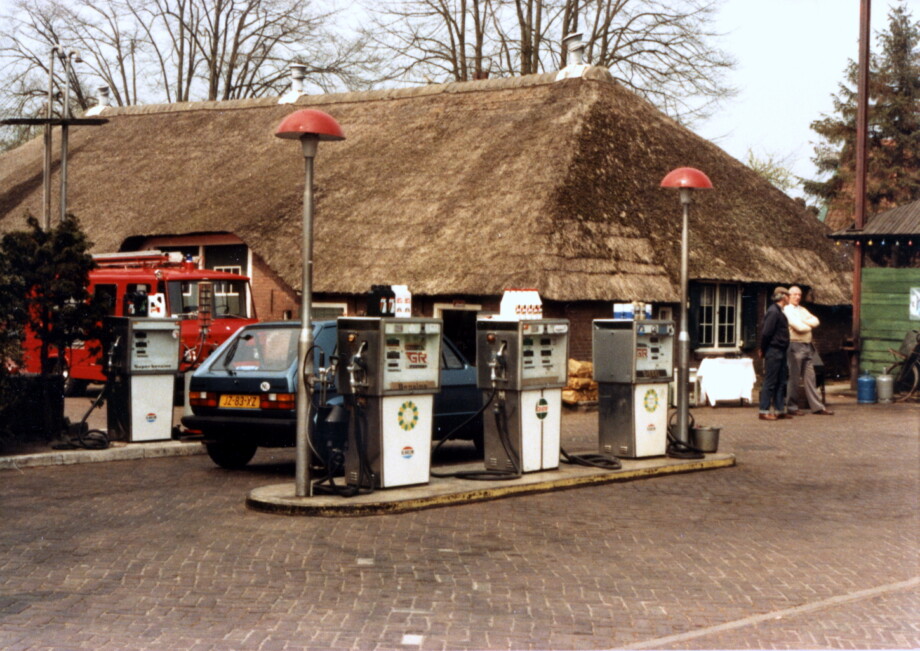
Photo of the gas station in +/- 1970
Below is another tanker truck, a DAF with a tender axle. This one also has the red, white, and blue livery.
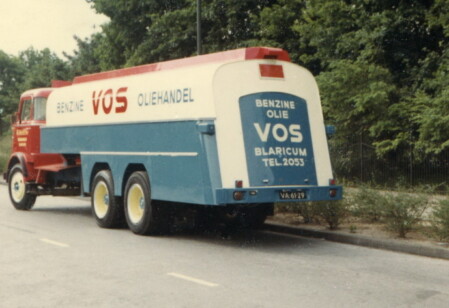
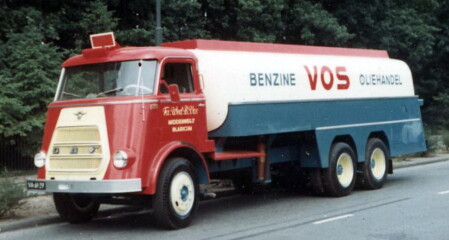
When Henk Vos became seriously ill, Gerard was asked to work at the company's gas station in the mornings and then drive to customers only in the afternoons, or vice versa.
The gas station proved to be the company's savior when fuel oil sales plummeted due to the oil crisis in the early 1970s. The garage was added in 1969.
Coal played a minor role at that time. After the war, the fuel company had over 2,800 coal customers; a mud of coal cost between ƒ7 and ƒ8 at the time. By 1980, there were still approximately 250 coal users left; the price of a mud had risen to ƒ42.
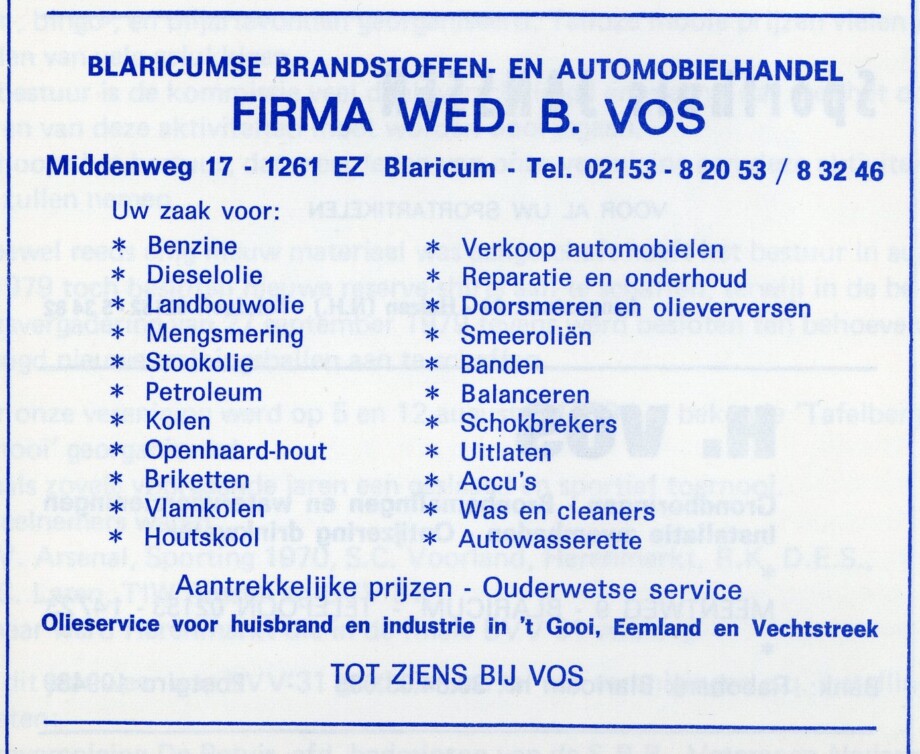
In 1978, the 18% sales tax was introduced on fuels. In the letter to customers below, the company states that it had to apply this under protest!
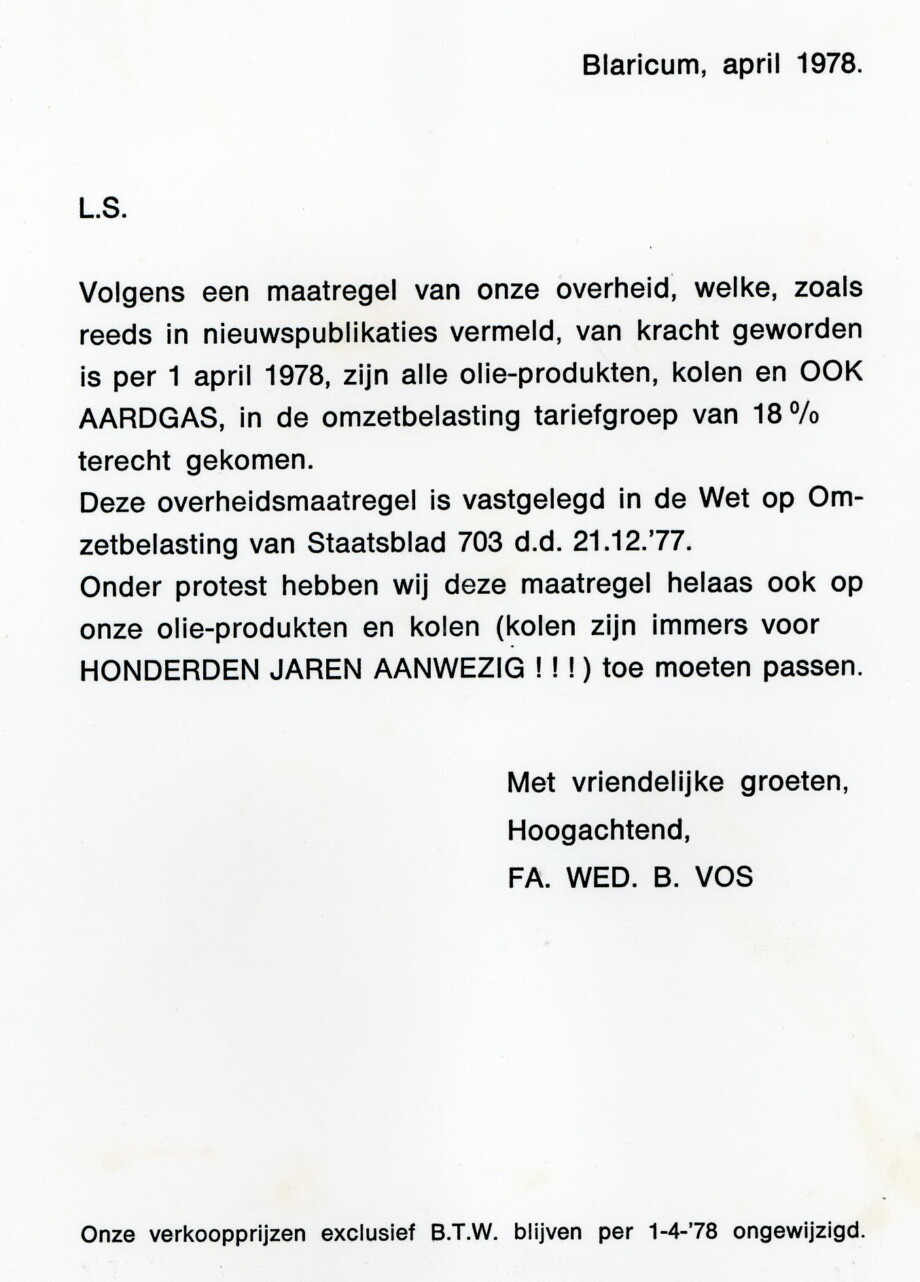
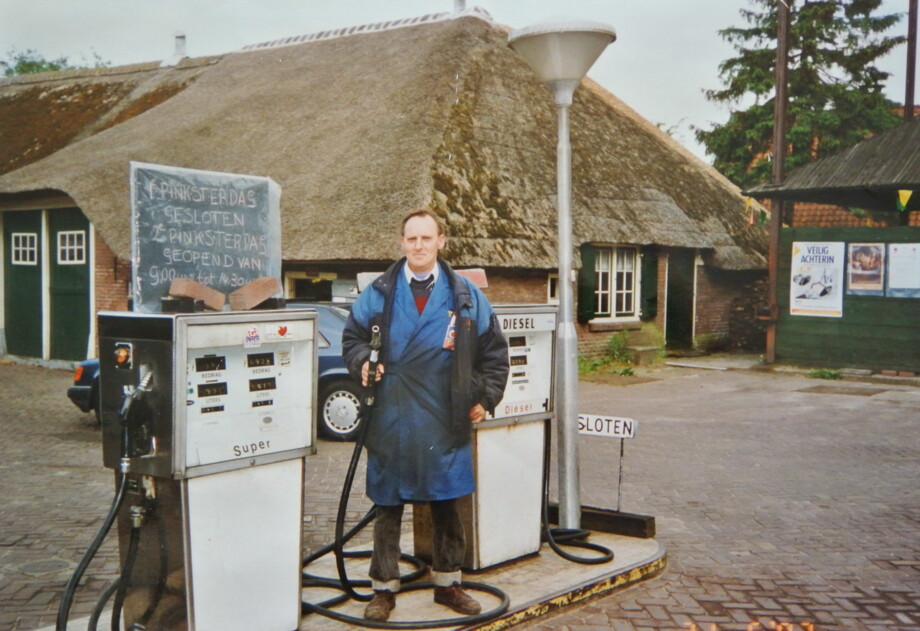
Gerard Vos at the gas pumps
Meanwhile, the Vos siblings had long since become owners of the company.
In 1992, Hans Vos took over the business from the family, and under Hans Vos's leadership, the company was modernized in 1997.
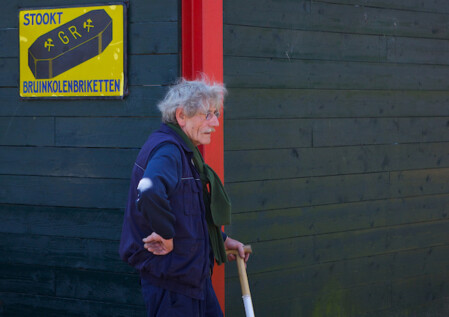
Hans was one of five children born to Willem Vos and his wife Gerda. "It's a wonderful company, always has been," he says with a touch of pride. "We always work together in our family. Way back when, Aunt Heintje, Aunt Geert with the administration, now there's Gerard, son of uncle Jaap, and there are many nephews. It's always been that way. That's what makes a company like this so positive. Together, and from father to son."
In the photo: Hans Vos at the haystack
In the garage, Hans became the office manager, and together with his cousin, Bep van Henk van Bart Vos, as mechanic, they held the reins firmly. In 1999, due to environmental regulations, the petrol pumps were decommissioned. A huge excavation was dug, and the pumps were automated.
The old family farm, from which the company had developed over the years, was still there. Remarkably, this farm had been largely preserved in its original state, including the original, period furnishings. This yielded interesting historical facts about the former way of life. It was almost unbelievable how pure and untouched the interior of the farm looked.
Old antique cabinets, chairs, box beds, the old stove on the iron floorboards of yesteryear, the old-fashioned lamps, window valances—everything exactly as it was two centuries ago. "Don't we have a real museum here?" Hans points to a glass dome in one of the glass cabinets. "Look," he says, "that's Aaltje's bridal bouquet, the one she married to Grandfather Bart. We'll keep it with care, you know."
Below are a few photos of the interior.
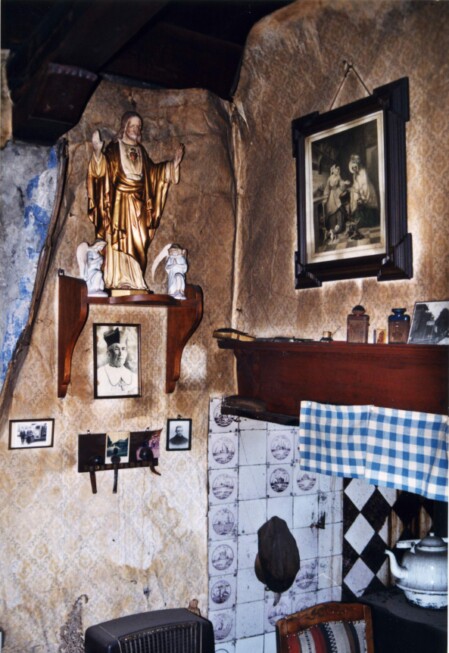
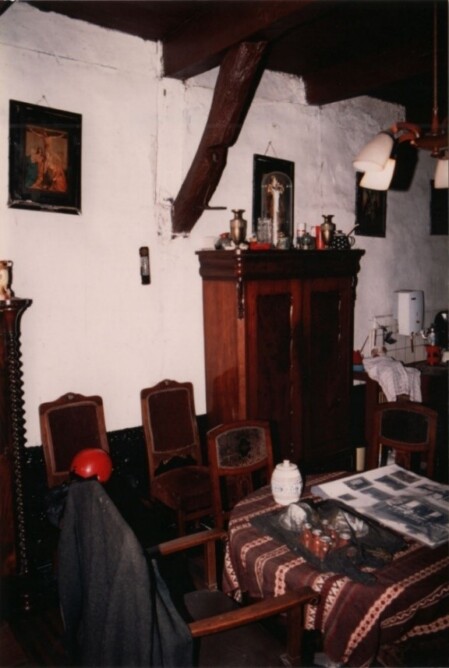
But then disaster struck. 2008 was a dark year in the company's history; an arsonist set fire to the farm. The perpetrator was caught and turned out to be a firefighter.
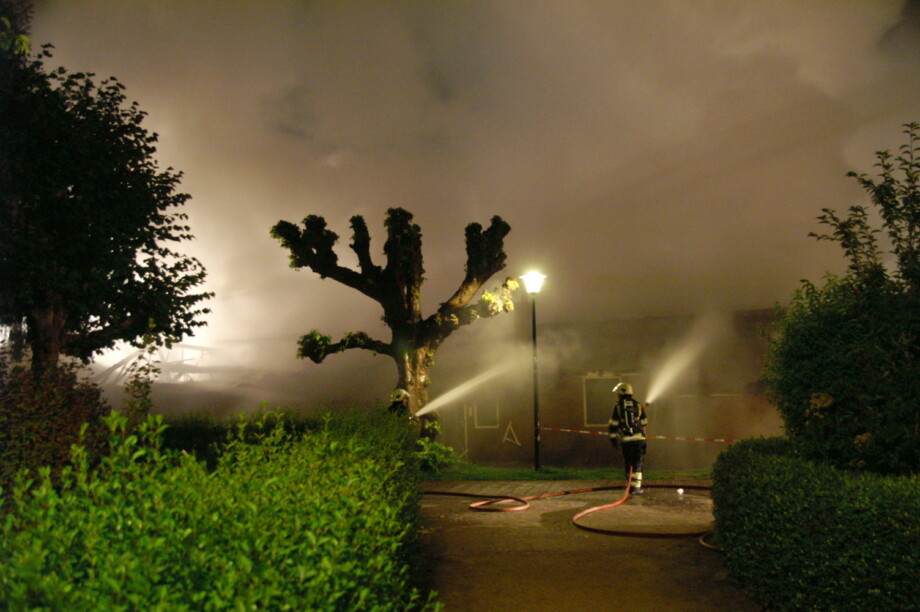
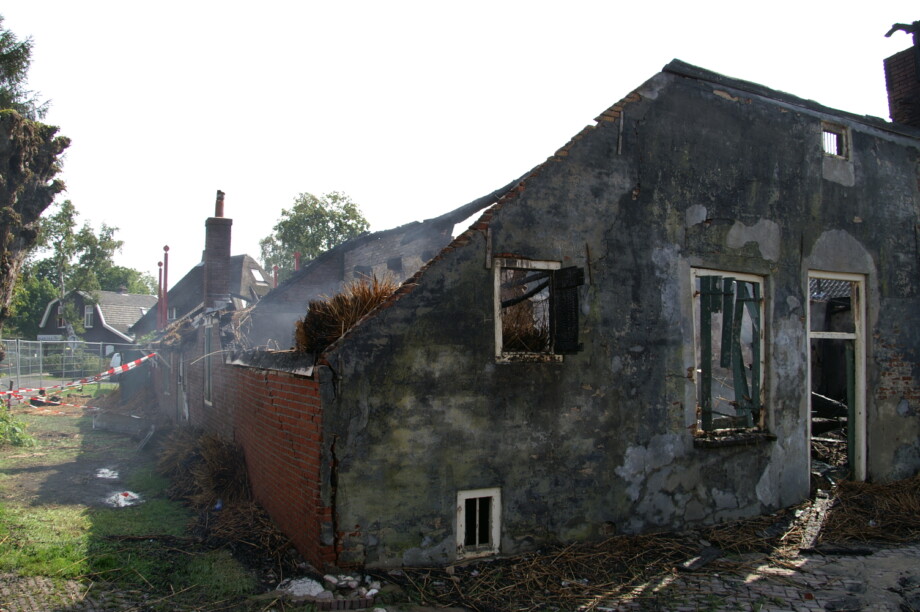
The farm was rebuilt in its original style, and the gas station and garage continued their operations.
Hans Vos then decided to take things easier and began discussions with his new successor, Maurice Bonke. Maurice had supplied fuel for his previous employer, including for the Vos company. The sale was finalized in early 2015. MBT Beheer B.V. became the new operator of the gas station.

The name was still Gasstation Vos.
Hans Vos still visited the business occasionally but passed away on August 31, 2017.
In 2020, the gas station was acquired by Fieten Olie.
The garage and the small shop are closed.
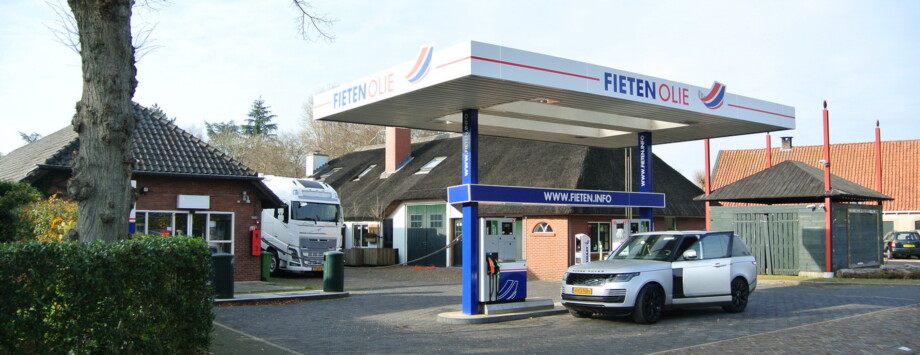
And with that, after some 130 years, the Vos family business has come to an end.
As a reminder of this family business, this sign still stands on the facade of Kerklaan 1, the former home of Jaap van Bart Vos and now of his son Co Vos and his wife.
